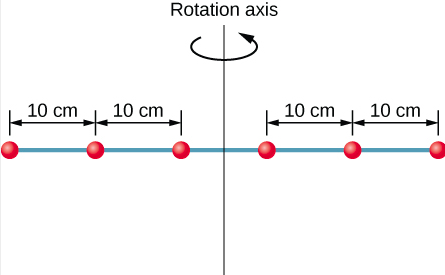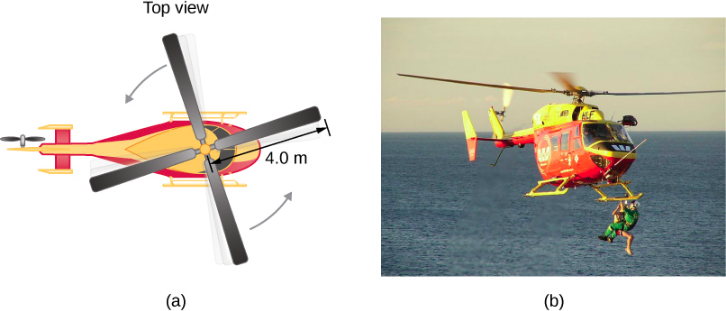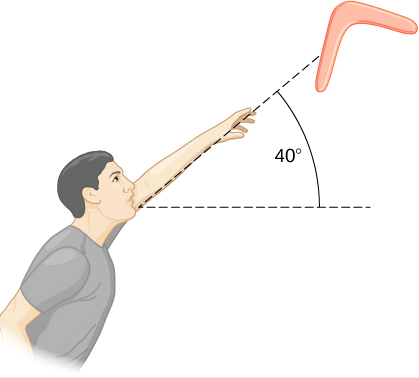11.3: Examples
( \newcommand{\kernel}{\mathrm{null}\,}\)
As you work through these examples, make sure to refer to the list of moments of inertia for different shaped objects, Table 6.1.1.

I am dragging a box full of 9 Emperor penguins along the ground as shown in the figure. Each of the penguins has a mass of 33.0 kg, and you can assume the box has zero mass. The rope which I am pulling the box with is making an angle of 22∘ with respect to the ground, and I pull the penguins a total distance of 15 m.
- If the tension in the rope is 50 N, how much work did I do on the box during this process?
- If the force due to friction between the box and ground is 25 N, how much work did friction do on the box during this process?
- How much work did gravity do on the penguins in the box during this process?
- Assuming the box of penguins starts from rest, how fast is the box moving after I pull it 15 m?
Six small washers are spaced 10 cm apart on a rod of negligible mass and 0.5 m in length. The mass of each washer is 20 g. The rod rotates about an axis located at 25 cm, as shown in Figure 11.3.3. (a) What is the moment of inertia of the system? (b) If the two washers closest to the axis are removed, what is the moment of inertia of the remaining four washers? (c) If the system with six washers rotates at 5 rev/s, what is its rotational kinetic energy?

Strategy
- We use the definition for moment of inertia for a system of particles and perform the summation to evaluate this quantity. The masses are all the same so we can pull that quantity in front of the summation symbol.
- We do a similar calculation.
- We insert the result from (a) into the expression for rotational kinetic energy.
Solution
- I=∑mjr2j=(0.02kg)(2×(0.25m)2+2×(0.15m)2+2×(0.05m)2)=0.0035kg⋅m2
- I=∑jmjr2j=(0.02kg)(2×(0.25m)2+2×(0.15m)2)=0.0034kg⋅m2
- K=12Iω2=12(0.0035kg⋅m2)(5.0×2πrad/s)2=1.73J
Significance
We can see the individual contributions to the moment of inertia. The masses close to the axis of rotation have a very small contribution. When we removed them, it had a very small effect on the moment of inertia.
Applying Rotational Kinetic Energy
Now let’s apply the ideas of rotational kinetic energy and the moment of inertia table to get a feeling for the energy associated with a few rotating objects. The following examples will also help get you comfortable using these equations. First, let’s look at a general problem-solving strategy for rotational energy.
- Determine that energy or work is involved in the rotation.
- Determine the system of interest. A sketch usually helps.
- Analyze the situation to determine the types of work and energy involved.
- If there are no losses of energy due to friction and other nonconservative forces, mechanical energy is conserved, that is, Ki+Ui=Kf+Uf.
- If nonconservative forces are present, mechanical energy is not conserved, and other forms of energy, such as heat and light, may enter or leave the system. Determine what they are and calculate them as necessary.
- Eliminate terms wherever possible to simplify the algebra.
- Evaluate the numerical solution to see if it makes sense in the physical situation presented in the wording of the problem.
A typical small rescue helicopter has four blades: Each is 4.00 m long and has a mass of 50.0 kg (Figure 11.3.5). The blades can be approximated as thin rods that rotate about one end of an axis perpendicular to their length. The helicopter has a total loaded mass of 1000 kg. (a) Calculate the rotational kinetic energy in the blades when they rotate at 300 rpm. (b) Calculate the translational kinetic energy of the helicopter when it flies at 20.0 m/s, and compare it with the rotational energy in the blades.

Strategy
Rotational and translational kinetic energies can be calculated from their definitions. The wording of the problem gives all the necessary constants to evaluate the expressions for the rotational and translational kinetic energies.
Solution
a. The rotational kinetic energy is
K=12Iω2
We must convert the angular velocity to radians per second and calculate the moment of inertia before we can find K. The angular velocity ω is
ω=300 rev 1.00min2π rad 1 rev 1.00min60.0s=31.4rads.
The moment of inertia of one blade is that of a thin rod rotated about its end, listed in Figure 11.3.4. The total I is four times this moment of inertia because there are four blades. Thus,
I=4Ml23=4×(50.0kg)(4.00m)23=1067.0kg⋅m2.
Entering ω and I into the expression for rotational kinetic energy gives
K=0.5(1067kg⋅m2)(31.4rad/s)2=5.26×105J.
b. Entering the given values into the equation for translational kinetic energy, we obtain
K=12mv2=(0.5)(1000.0kg)(20.0m/s)2=2.00×105J.
To compare kinetic energies, we take the ratio of translational kinetic energy to rotational kinetic energy. This ratio is
2.00×105J5.26×105J=0.380.
Significance
The ratio of translational energy to rotational kinetic energy is only 0.380. This ratio tells us that most of the kinetic energy of the helicopter is in its spinning blades.
A person hurls a boomerang into the air with a velocity of 30.0 m/s at an angle of 40.0° with respect to the horizontal (Figure 11.3.6). It has a mass of 1.0 kg and is rotating at 10.0 rev/s. The moment of inertia of the boomerang is given as I=112mL2 where L = 0.7 m. (a) What is the total energy of the boomerang when it leaves the hand? (b) How high does the boomerang go from the elevation of the hand, neglecting air resistance?

Strategy
We use the definitions of rotational and linear kinetic energy to find the total energy of the system. The problem states to neglect air resistance, so we don’t have to worry about energy loss. In part (b), we use conservation of mechanical energy to find the maximum height of the boomerang.
Solution
a. Moment of inertia: I=112mL2=112(1.0kg)(0.7m)2=0.041kg⋅m2.
Angular Velocity: ω=(10.0rev/s)(2π)=62.83rad/s
The rotational kinetic energy is therefore
KR=12(0.041kg⋅m2)(62.83rad/s)2=80.93J
The translational kinetic energy is
KT=12mv2=12(1.0kg)(30.0m/s)2=450.0J
Thus, the total energy in the boomerang is
KTotal =KR+KT=80.93+450.0=530.93J.
b. We use conservation of mechanical energy. Since the boomerang is launched at an angle, we need to write the total energies of the system in terms of its linear kinetic energies using the velocity in the x- and y-directions. The total energy when the boomerang leaves the hand is
EBefore =12mv2x+12mv2y+12Iω2
The total energy at maximum height is
EFinal =12mv2x+12Iω2+mgh
By conservation of mechanical energy, EBefore=EFinal so we have, after canceling like terms,
12mv2y=mgh.
Since vy = 30.0 m/s (sin40∘) = 19.28 m/s, we find
h=(19.28m/s)22(9.8m/s2)=18.97m
Significance
In part (b), the solution demonstrates how energy conservation is an alternative method to solve a problem that normally would be solved using kinematics. In the absence of air resistance, the rotational kinetic energy was not a factor in the solution for the maximum height.
A nuclear submarine propeller has a moment of inertia of 800.0 kg • m2. If the submerged propeller has a rotation rate of 4.0 rev/s when the engine is cut, what is the rotation rate of the propeller after 5.0 s when water resistance has taken 50,000 J out of the system?


